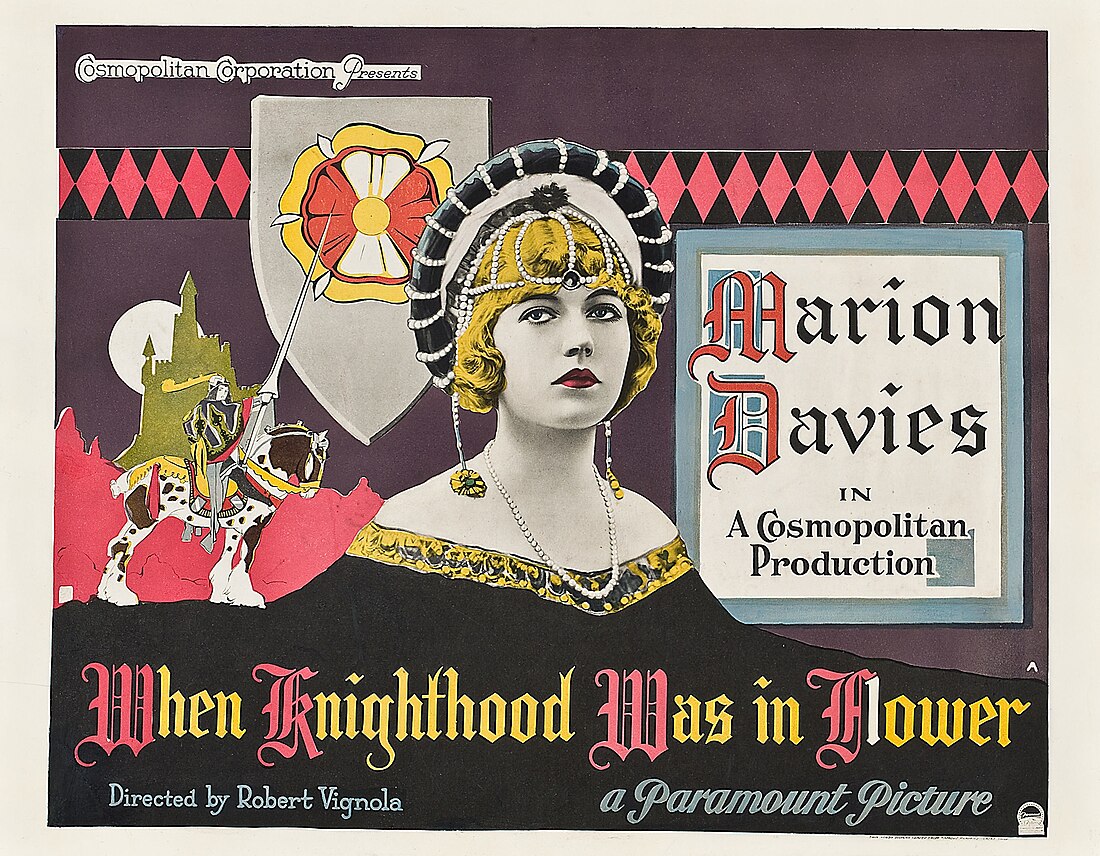Top Qs
Timeline
Chat
Perspective
When Knighthood Was in Flower (1922 film)
1922 film From Wikipedia, the free encyclopedia
Remove ads
When Knighthood Was in Flower is a 1922 American silent historical film directed by Robert G. Vignola, based on the novel by Charles Major and play by Paul Kester. The film was produced by William Randolph Hearst (through his Cosmopolitan Productions) for Marion Davies and distributed by Paramount Pictures. This was William Powell's second film. The story was re-filmed by Walt Disney in 1953 as The Sword and the Rose, directed by Ken Annakin.[2][3]
Remove ads
Remove ads
Plot
Mary Tudor is forced by her brother Henry VIII to marry Louis XII as part of a peace agreement, but she falls in love with Charles Brandon. Mary flees with him, but the two lovers are captured. Brandon is framed for murder and Mary agrees to marry Louis XII if his life is spared. Brandon is exiled and Louis XII, old and sick, dies shortly after the wedding. After an attempt on the part of Louis XII's nephew Francis I to wed Mary, she finally marries Brandon.
Remove ads
Cast

- Marion Davies as Mary Tudor
- Forrest Stanley as Charles Brandon
- Lyn Harding as Henry VIII
- Teresa Maxwell-Conover as Queen Catherine (credited as Theresa Maxwell Conover)
- Pedro de Cordoba as Duke of Buckingham
- Ruth Shepley as Lady Jane Bolingbroke
- Ernest Glendinning as Sir Edwin Caskoden
- Arthur Forrest as Cardinal Wolsey
- Johnny Dooley as Will Sommers
- William Kent as King's tailor
- Charles K. Gerrard as Sir Adam Judson
- Arthur Donaldson as Sir Henry Brandon
- Downing Clarke as Lord Chamberlain
- William Norris as Louis XII
- Macey Harlam as Duc de Longueville
- William Powell as Francis I (credited as William H. Powell)
- George Nash as An adventurer
- Gustav von Seyffertitz as Grammont
- Paul Panzer as Captain of the Guard
- Flora Finch as French countess
- Guy Coombs as Follower of Buckingham
Remove ads
Production
Exteriors were shot at Windsor Castle, England. With an estimated cost of $1,500,000, it was considered by Life "the most expensive film that has ever been produced" in 1922.[4][5] According to Variety, William Randolph Hearst launched "the most expensive and extensive campaign that has ever been organized for anything theatrical", with over 650 billboards in New York, 300 subway advertising placards, special booths in department stores that sold souvenir books, and a dazzling string of electric signs that pervaded Times Square, upon which Will Rogers quipped that Davies's next film would be titled When Electric Light Was in Power.[6]
Marion Davies makes her entrance coming down the river on a royal barge. The barge was a full-sized replica built in Bridgeport, Connecticut. The scene and the dance were filmed on the Laddins Rock Farm in Stamford/Old Greenwich, Connecticut.[7][5] Hearst commissioned two songs from Victor Herbert: "The When Knighthood Was in Flower Waltz" and "The Marion Davies March," which were played at the New York premiere.[8]
Reception
Summarize
Perspective

Robert E. Sherwood defined the film "gorgeously beautiful [...] flashily romantic and stirringly impressive",[9] ranking it as one of the best pictures of the year[10] and appreciated Vignola's "genius for lighting and composition".[11] In 1922, Motion Picture News stated the film was "not only Cosmopolitan's greatest achievement [but] one of the greatest achievements of the silversheet", wrote a positive review of the cast and praised Vignola "for his masterly direction".[12]
Delight Evans cited the film among "the most entertaining photoplays ever made" on Photoplay in 1923.[13] It was ranked #10 on Screenland's reader poll of "The Ten Best Screenplays Ever Made" in 1924.[14] The Motion Picture Guide praised the film for its "tremendous production values, excellent direction, a good script, and an outstanding cast", giving it three out of four stars.[15]
It was a triumph for Marion Davies, and she was named "Queen of the Screen" and the #1 female box office star of 1922 at the annual theater owners ball (Rudolph Valentino was named #1 male star).[16] However, the movie was negatively received in London and, according to Davies, the English did not accept an American woman playing an English character. Despite the controversy, it was appreciated by Edward, Prince of Wales, who defined it "a wonderful picture".[17] British art dealer Joseph Duveen stated the film setting was "the most stupendous reproduction of Henry the Eighth court life that has ever been achieved — a marvelous piece of artistry".[18]
Remove ads
Legacy
The film was spoofed in Broncho Billy Anderson's When Knights Were Cold (1923), starring Stan Laurel and Mae Dahlberg.[19]
Ben Model used portions of the songs commissioned by Hearst for the film's New York premiere in his theatre organ score for the 2017 restoration of the film. The restored film was scanned from an original 35mm nitrate print preserved by the Library of Congress. Its color tints have been reinstated and the film's hand-colored sequence has been digitally replicated. The first time this restored Knighthood was seen just "as it appeared in the 1920s" was at a special screening in May 2023 at New York City's historic Jefferson Market Library.[20]
Remove ads
References
External links
Wikiwand - on
Seamless Wikipedia browsing. On steroids.
Remove ads

